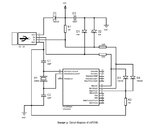Mithun_K_Das
Advanced Member level 3
- Joined
- Apr 24, 2010
- Messages
- 899
- Helped
- 24
- Reputation
- 48
- Reaction score
- 26
- Trophy points
- 1,318
- Location
- Dhaka, Bangladesh, Bangladesh
- Activity points
- 8,254
Is it possible to make a virtual COM port using PIC16F73 via USB cable ? If there is any way to make a communication using just USB cable it will be great.
Note: I know USB communication, Serial Communication well so don't ask any odd questions.
What My plan is to know if it is possible to make a communication between PIC16F73 and PC via Serial communication without using any MAX232 and Serial cable.
I just want to use USB cable. No MAX232 or serial to usb converter. Is it really possible with PIC?
I found many examples but they are all with ATMEGA8. So my curiosity is, if its possible with PIC16F73 as both atmega8 and PIC16F73 have no USB module inside. So if its possible with atmega8, then it should be possible with PIC16F73.
TIA
Note: I know USB communication, Serial Communication well so don't ask any odd questions.
What My plan is to know if it is possible to make a communication between PIC16F73 and PC via Serial communication without using any MAX232 and Serial cable.
I just want to use USB cable. No MAX232 or serial to usb converter. Is it really possible with PIC?
I found many examples but they are all with ATMEGA8. So my curiosity is, if its possible with PIC16F73 as both atmega8 and PIC16F73 have no USB module inside. So if its possible with atmega8, then it should be possible with PIC16F73.
TIA

